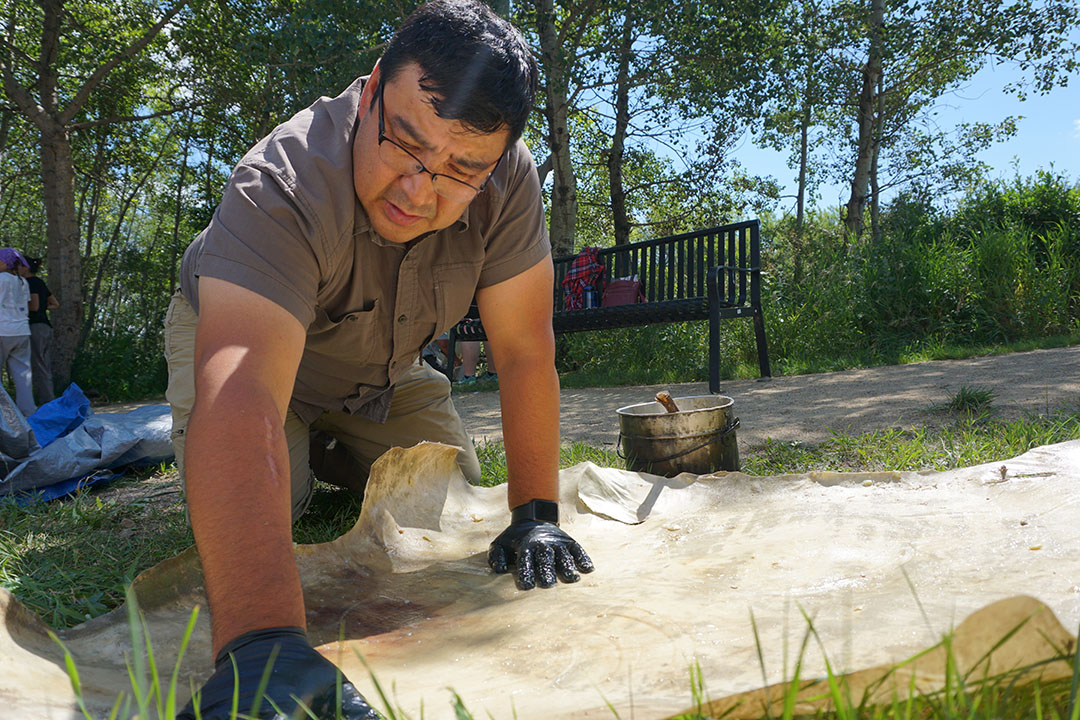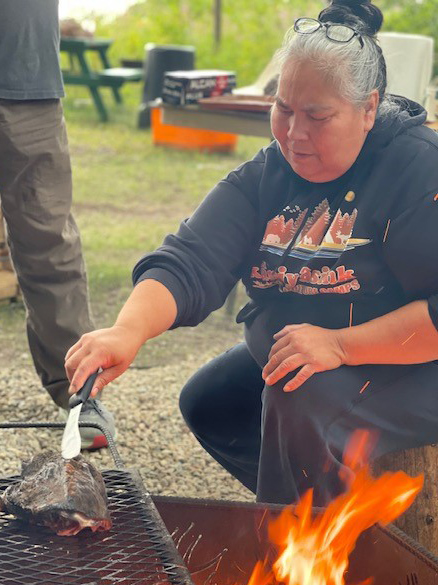
ê-kiwêtotamahk anima kâkî-mîkôsiyahk pîkiskwêwin | USask professor bringing back the languages of Turtle Island
For Dr. Kevin wâsakâyâsiw Lewis (ipkDoc), every Indigenous person has the right to learn their language.
By Meagan Hinther“It’s our Elders that are telling us – teach the young ones, teach them the language and we will be stronger,” said wâsakâyâsiw Lewis.
wâsakâyâsiw Lewis is nêhiyaw (Plains Cree) from Ministikwan Lake Cree Nation in Treaty 6 Territory. An assistant professor in the Department of Curriculum Studies in the University of Saskatchewan (USask) College of Education, he developed and launched the college’s Indigenous Languages Certificate (ILC) in 2015 in conjunction with the Indian Teacher Education Program. This work built on wâsakâyâsiw Lewis’ more than 20 years as an educator, researcher, scholar, knowledge and language keeper, and founder of kâniyâsihk Culture Camps at Ministikwan Lake.
The ILC focuses on immersing students in the three dialects of Cree found in Saskatchewan: nêhiyawêwin (Plains Cree, ‘y’ dialect), nêhinawêwin (Swampy Cree, ‘n’ dialect), and nîhithawîwin (Woodland Cree, ‘th’ dialect). The program includes 10 courses taken over two years.
“Cree is such a wonderful language. A lot of our people went to residential school. We were all impacted by colonization. A lot of our relatives didn’t get to learn nêhiyawêwin,” wâsakâyâsiw Lewis shared. “When we developed this program, it was with that in mind. Maybe it’s time to go back to the languages from Turtle Island.”
As Canada marks National Indigenous Languages Day on March 31, wâsakâyâsiw Lewis is on a mission to share how far-reaching Cree is, and points out that there are speakers all over Saskatchewan, Alberta and Manitoba, and into Montana.
“Here’s one of my favourite lame jokes: behind every tree is a Cree!” said wâsakâyâsiw Lewis with a laugh, his warm sense of humour on display during a recent webinar promoting the ILC to interested educators.
Through the courses in the certificate, students develop proficiency in how to speak and teach Cree by learning Indigenous teaching methodologies. The ILC is open to anyone who wishes to learn an Indigenous language, and students enter the program with varied ability to speak Cree, from beginner to fluent speakers. The certificate is structured in such a way that each course builds on the last, with students learning from one another while improving their fluency and language skills.
“The way we speak Cree is in word sentences, so you can’t use a grammatically structured language like English and French to develop the teaching methods. We have to teach Cree in the way it’s supposed to be taught – it’s like peeling back an onion, with different layers of learning,” wâsakâyâsiw Lewis said.
Courses take place on weekends for accessibility, as most of the ILC students are K-12 teachers. In addition to teaching students how to write and teach Cree using syllabics and using the letters of the English alphabet, the courses use literacy techniques such as the Cree root word method, and methods such as total physical response and drama for language learning. Other courses focus on traditional and contemporary music, song, and dance.
“It’s been so great to teach these students, it’s felt so easy. The people that have a passion for language are joining the ILC, they want to learn how to write in syllabics, they want to learn song, they want to learn the different dances from powwow and ceremony,” said wâsakâyâsiw Lewis.

Candace Longjohn, long-time educator and 2021 ILC graduate from Sturgeon Lake First Nation, agrees.
“I think that’s the heart of the program, is getting immersed with language teachings that have had hands-on practices for understanding better our spirituality and putting into practice our values and beliefs as Cree people. I think people need to know our belief system to be able to understand why language is so important to us. Language is in every part of our culture,” shared Longjohn.
Longjohn has taught Cree to high school students in Prince Albert for the past 19 years and holds a Bachelor of Education and Bachelor of Arts degree from USask, with teaching areas of Cree, Native Studies, and English. She joined the ILC in 2018.
“While taking the ILC, it felt like all the pieces—my combined knowledge and fluency—of the puzzle were being fit into place,” said Longjohn. “The courses teach a wholistic way of learning and teaching nêhiyawêwin through contemporary and traditional music, dance, art, storytelling, and ceremony. The program solidified my confidence in myself and my own teaching to incorporate more spirituality, âtayohkêwina, the original stories, our legends into daily lessons. I think that’s really important for the students I teach. If they see the confidence in the teacher, they are going to have confidence in themselves.”
For the final course of the certificate, students spend time putting into practice what they’ve learnt at wâsakâyâsiw Lewis’ kâniyâsihk Culture Camps at Ministikwan Lake. Each ILC student is tasked with teaching young students in kâniyâsihk’s land-based immersion school kâ-nêyâsihk mîkiwâhpa (Cree Academy of Excellence). The lesson is related to the land and taught entirely in Cree.
“I taught rabbit snaring. Other students taught how to filet a fish; how to set a net. Others taught how to cook a fish; somebody did Bannock making as their lesson,” said Longjohn.
To prepare for the rabbit snaring lesson, Longjohn went back to her home community of Sturgeon Lake to learn from her relatives who were fluent language speakers.
“To prepare, I videotaped and took pictures of them teaching me how to make a snare, where to set the snare and check it, and with all the possible Cree terminology that would go with snaring and the tools,” explained Longjohn. “My mom taught me how to skin the rabbit and how to make a traditional rabbit soup – all in Cree.”
In addition to strengthening her relationship and commonalities with her community, taking the ILC has also deepened Longjohn’s relationship with her father.
“He phones every day, he’ll say ‘What are you having for supper [mêskwa, tânisi âtawiya? kîkway ê-mîciyan?],’ and he’ll want my daughters and I to respond in Cree,” shared Longjohn. “Before the ILC classes, there was no Cree conversations between my parents and I, only English. It’s so much more fun now. We’re closer with having the language shared between us.”
The connection between generations that language learning fosters, and the commitment of those that have come before him is what drives wâsakâyâsiw Lewis in his mission to bring back the languages of Turtle Island.
“We need to create more Cree-immersion schools and teachers so that the language health in our communities keeps rising. We have legislation in the Indigenous Languages Act that Elders have worked hard at,” said wâsakâyâsiw Lewis. “I’m the luckiest guy on Earth, because this is what I get to do, and I give my acknowledgement to my parents, my community, my uncles, my aunts, my grandmothers and my grandfathers for having language so strong that it’s given me a career.”
For more information about the Indigenous Languages Certificate and admission details, click here.

